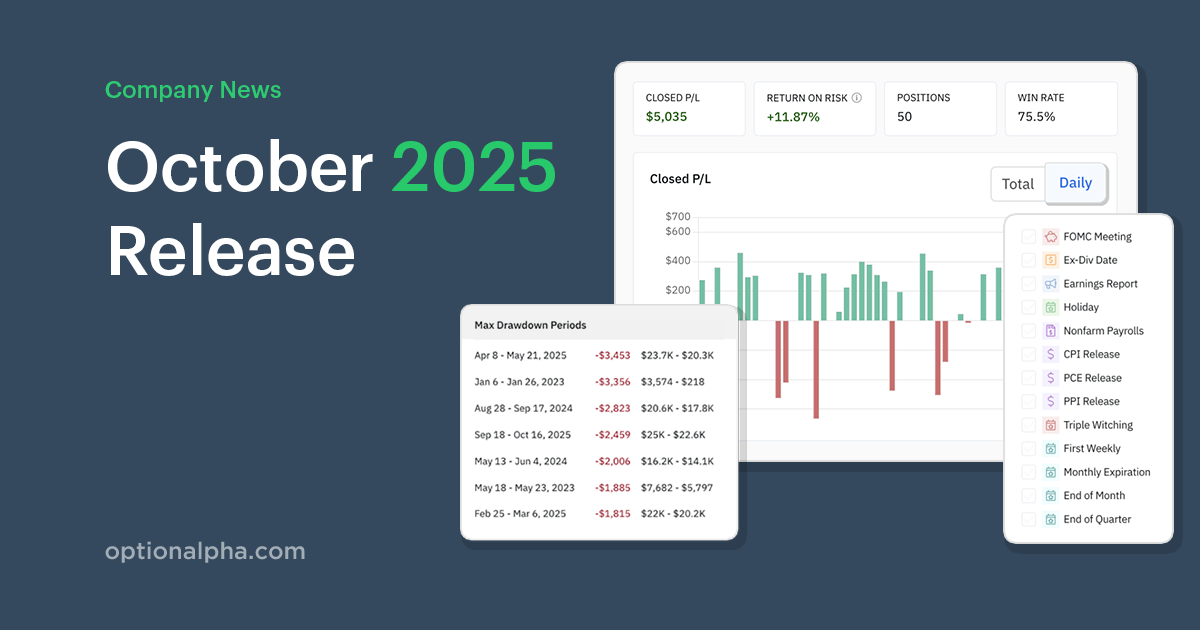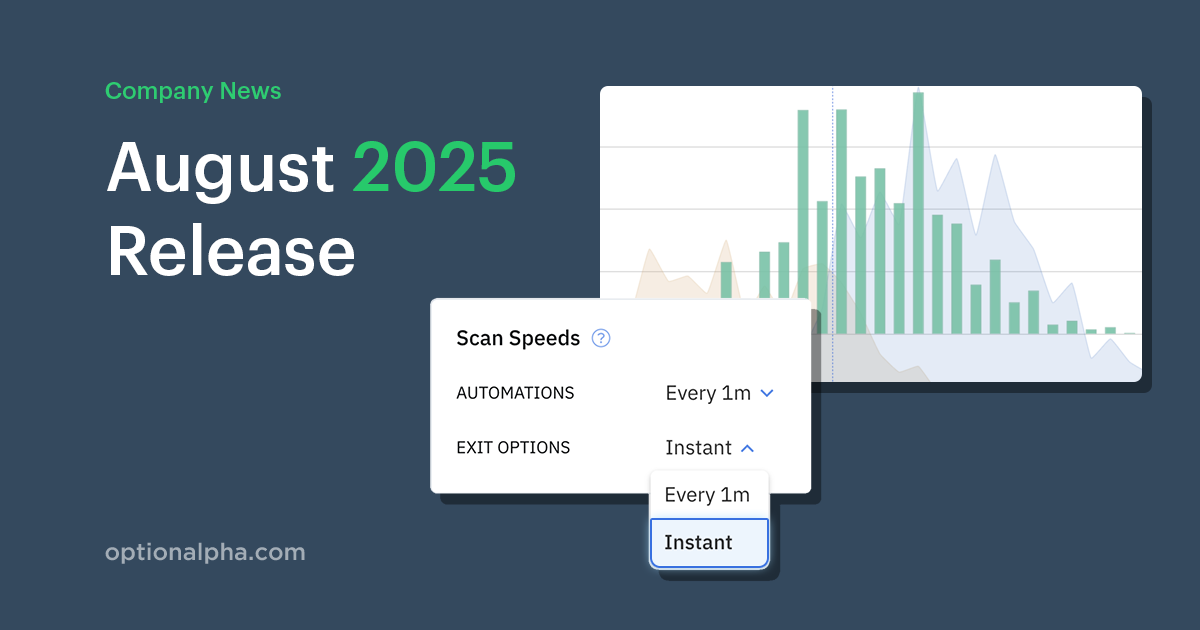Flashback: March 2020. The pandemic that at first was regionally contained has become a global health threat with increasing financial implications. Markets are falling fast, triggering circuit breakers and leaving unprepared traders overexposed and saddled with losing positions.
The Pandemic Crash was the fastest drop in history from all-time highs to correction territory.

Hedged traders were not totally immune to the panic, but their portfolios were more stable and better prepared to capitalize on the subsequent rally than those without portfolio protection.
Strategies like Option Alpha’s VIX hedging strategy or buying deep-out-of-the-money (OTM) put options (i.e., “unit puts”) were incredibly effective during the Pandemic Crash. However, today’s pricing of VIX options and OTM puts has dramatically reduced the same strategies’ price efficiency and downside protection.
Traders talk about VIX and SPX tail risk pricing being astronomically high compared to before the pandemic. How significant is this price change? What has happened to the price of downside protection?
We studied almost two decades of deep-OTM SPX put option pricing data to get you the answers.
Hedging Tail Risk with OTM Puts
One way to hedge a portfolio is to purchase far OTM put contracts on major indices. Certain put contracts are sometimes referred to as “units” or “unit puts” because they trade at round dollar amounts or specific deltas, and each contract represents a “unit” of protection.
A unit put is a far out-of-the-money put contract with Greeks that do not follow the uniform patterns of closer-to-the-money contracts. Low delta unit puts react uniquely during volatility events. Worried investors buy downside protection en masse, causing a positive feedback loop as demand exceeds supply, creating an “explosion” in far OTM put pricing.
This explosion provides downside protection (a hedge) that can protect an investor from disastrous losses and possibly even generate a profit during significant market volatility.
Many authors have described the repricing of low delta options during volatility events. See Chen and Sebastian’s The Option Trader’s Hedge Fund for further discussion on unit puts or Krishnan’s The Second Leg Down for more on options pricing in a volatile environment.
Traders have several options for strike and expiration selection when hedging with OTM puts. For example, you could hedge by regularly buying the front month, .05 delta SPX put option. Figure 2 shows the profitability of a series of those individual trades, rolling into new contracts at 15 DTE. Each data point in the plot is a particular trade’s profit or loss.

This hedging strategy served its purpose in March 2020. The highest bar shows the profit for a closed put contract on March 12, 2020. That single trade produced $24,770 as the front month, .05 delta put increased 3,440% in 15 days.
While the hedge was effective during that volatility, the contracts in this example typically expired worthless, leaving the holder with a slight loss (the cost of the put option). This creates a long-term portfolio drag, shown in Figure 3 by plotting the cumulative profit (loss) of the strategy.

Like the VIX “Doomsday Hedge,” the protection from unit puts was well worth the cost during the Pandemic Crash. But, the constant protection put buying in the years leading up to the crash created sustained portfolio drag. What does pricing look like today?
SPX Options Pricing Case Study
Hedging to avoid or mitigate portfolio losses during significant market declines is a popular topic. A diversified investor can handle small losses, but correction-level events take a toll on the unprotected investor’s long-term returns. But how much are you willing to pay for that protection?
Just as homeowner’s insurance increases after a series of storms, the price of hedging increases as a result of market volatility. By how much does it increase, and how long does it last?
Using SPX options data from February 2005 through July 2021, we studied the magnitude and duration of pricing volatility.
Downside Protection Pricing Changes
There is no strict definition of tail-risk protection puts (“unit puts”), so we analyzed 15 combinations of DTE and deltas. We considered 30, 45, 60, 90, and 120 DTE contracts, each with the .03, .05, and .10 deltas.
To understand pricing changes, we calculated the mid-price for the contract that best fit our criteria each day at 3:45 PM EST. We evaluated all expiration types, tracking the contract that best matched our defined DTE and delta, regardless of weekly, monthly, or quarterly expiration. We split our data into equal-sized pre and post-Pandemic Crash datasets.
- Pre-Pandemic Crash Dataset: 10/24/2018 - 3/16/2020 (n=348)
- Post-Pandemic Crash Dataset: 3/16/2020 - 7/30/2021 (n=348)
Figure 4 shows the average contract prices before and after the Pandemic Crash.

The blue points correspond to the right-side axis and show the percentage change between pre and post-pandemic pricing.
The cost of deep-out-of-the-money puts after the Pandemic Crash is significantly higher, with some contracts nearly doubling their average mid-price.
The average price increase for all definitions of unit puts shown in Figure 4 is +89%.
All unit-put definitions showed a sustained pricing increase following the Pandemic Crash, but pricing increases were larger in higher DTE contracts and lower delta contracts.
While there are clear relationships, the right-side y-axis’ relatively narrow range of +80-100% shows us that the differences in price increases between contracts is small.
The minimum price change was +80% by the .10 delta, 30 DTE contract, and the maximum average increase was +100% by the .03 delta, 120 DTE contract.
Looking at pricing from a different angle, Figure 5 shows contract pricing for the .05 delta, 30 DTE puts and .05 delta, 120 DTE puts, overlaid with VIX values.

The pricing spike in 2008 is the eye-catcher in Figure 5, but that is not the focus of our current discussion. Notice that while the VIX has settled near its long-term average over the period studied (19.1), the pricing for both contract types remains elevated after 2020.
For the 120 DTE trades (blue), notice how infrequently pricing has remained above the VIX line. For the 30 DTE trades (green), imagine a horizontal line moving left from the current VIX value. Wherever that line touches a VIX point, look down at the green scatter points and notice how much lower they are than our current pricing.
While this volatility environment is historically unique, our data included other examples of increased downside protection costs, notably the 2008 Financial Crisis and 2018 trade war sell-off. What can those examples teach us about the duration of inflated protection pricing?
How Long Do Price Spikes Last?
OTM put pricing increases during and following a volatility event. How long does it take for pricing to normalize after a spike in volatility?
To answer this question, we looked at pricing spikes during the Financial Crisis, 2016, and 2018.
To help visualize duration, we calculated the 60-day average contract cost before the pricing increases. That average is shown by the blue horizontal line in each plot.
We defined mean reversion as when the pricing scatter plot fell below that 60-day average line for multiple trading days. As you will see in the plots, this did not always happen, and there may not be a “typical” duration of increased put protection pricing.
Financial Crisis Tail-Risk Pricing

As shown in Figure 6a, protection puts had a historic price spike in late 2008, but the extreme pricing reverted to normal levels within two weeks. The 2008 VIX spike was the largest on record before the Pandemic Crash in 2020. Despite that historic volatility, the extreme protection pricing appears to have had an insignificant duration.
The scale of Figure 6a prevents us from seeing the more typical pricing trends produced by the volatility of the Financial Crisis. A second image will correct this.

We plotted the same data as in the previous figure but removed the 11 high-magnitude data points. This lowered the left y-axis price scale from 1-100 to 1-10. The pre-event 60-day average and VIX values are unchanged. On this updated scale, it’s easier to see that pricing did not truly mean-revert for nearly six months.
While there were short-lived, high-magnitude pricing increases in protection puts during the Financial Crisis, behind those extreme events were more sustained pricing increases and a slower reversion to the mean.
2015-2016 Tail Risk Pricing

In 2015, protection pricing rose as the market entered correction territory. Similar to the second example during the Financial Crisis, prices slowly mean reverted following the initial spike. While they did fall below the 60-day average about two months after the initial pricing increase, contract prices did not persist below that level until April 2016, nearly eight months after the initial price increase.
2018 Tail Risk Pricing

In more recent memory, 2018 offers a unique look at the duration of elevated put pricing. Starting in February with inflation fears and ending with volatility due to the onset of the China-USA trade war, put protection pricing remained elevated the entire year.
Throughout 2019, leading up to the Pandemic Crash, put protection prices never reverted to their previous level.
These historical examples bring us back to our current focus. The Pandemic Crash elevated put pricing beyond its already historically high levels.

Looking back through the charts, this pricing level relative to the VIX would have been unimaginable during previous volatility events. Protection pricing has fallen some since the Pandemic Crash but it is still well above the already-elevated previous levels.
The magnitude and duration of protection put pricing is largely unpredictable. However, we learned that the price to protect your portfolio with OTM puts has still not mean-reverted since the 2018 increase. The volatility from the Pandemic Crash took these prices to another level despite a strong recovery in the indices, and consistent new ATHs in the second half of 2020 and 2021.
The past does not give a reliable indication of how long elevated pricing will persist or if it will mean revert, but it appears that traders are preparing for the “unknown unknown” by prioritizing downside protection.
Tying It All Together
Hedge pricing has dramatically risen since the Pandemic Crash, with longer-dated options experiencing the highest increase. Historically, the duration of increased pricing has been largely unpredictable, with some events lasting only a few months and others persisting for years.
After a market correction or a significant spike in volatility, hedging is on many investors’ minds. With the pain of the last portfolio decline still fresh, traders line up for portfolio protection in hopes of preventing it from happening again.
As demand rises for out-of-the-money protection, prices rise. There are opportunistic sellers to the buyers lining up for protection, willing to purchase puts despite the relatively high premiums. As markets settle down and volatility subsides, investors tire of paying premiums for portfolio protection and demand subsides, causing put prices to decline. Then, when a volatility event happens occurs, the unhedged are exposed yet again, and the cycle repeats.
The price of portfolio protection ebbs and flows. When protection pricing is high, perhaps pursue alternative hedging strategies. When it is low, don’t get lulled into complacency and skip out on protecting your downside.



.png)










